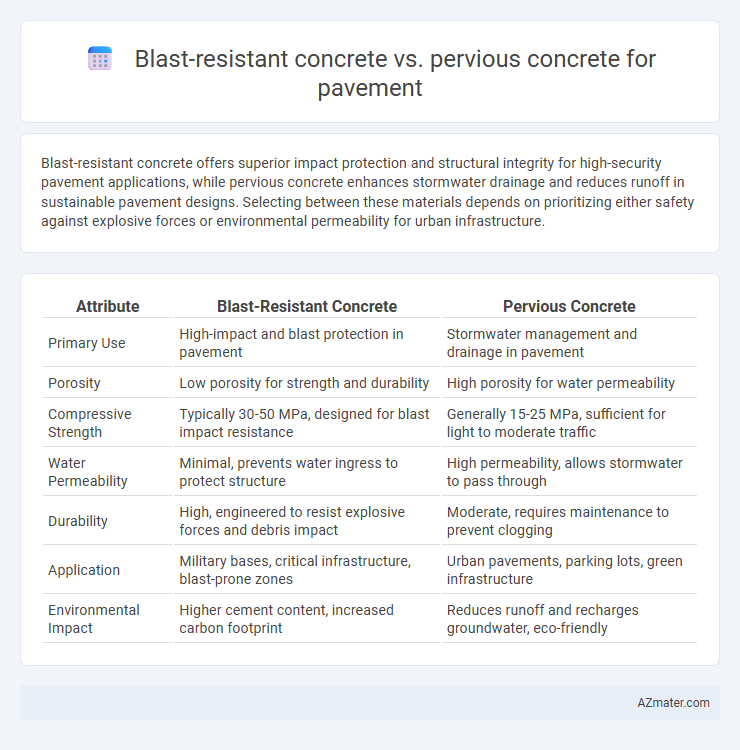Blast-resistant concrete offers superior impact protection and structural integrity for high-security pavement applications, while pervious concrete enhances stormwater drainage and reduces runoff in sustainable pavement designs. Selecting between these materials depends on prioritizing either safety against explosive forces or environmental permeability for urban infrastructure.
Table of Comparison
| Attribute | Blast-Resistant Concrete | Pervious Concrete |
|---|---|---|
| Primary Use | High-impact and blast protection in pavement | Stormwater management and drainage in pavement |
| Porosity | Low porosity for strength and durability | High porosity for water permeability |
| Compressive Strength | Typically 30-50 MPa, designed for blast impact resistance | Generally 15-25 MPa, sufficient for light to moderate traffic |
| Water Permeability | Minimal, prevents water ingress to protect structure | High permeability, allows stormwater to pass through |
| Durability | High, engineered to resist explosive forces and debris impact | Moderate, requires maintenance to prevent clogging |
| Application | Military bases, critical infrastructure, blast-prone zones | Urban pavements, parking lots, green infrastructure |
| Environmental Impact | Higher cement content, increased carbon footprint | Reduces runoff and recharges groundwater, eco-friendly |
Introduction to Blast-Resistant and Pervious Concrete
Blast-resistant concrete enhances pavement safety by incorporating high-strength materials and energy-absorbing aggregates designed to withstand explosive forces, reducing structural damage and ensuring durability in hazardous environments. Pervious concrete improves stormwater management and reduces surface runoff through its porous structure, allowing water to permeate and recharge groundwater, which is crucial for sustainable urban infrastructure. Both materials play distinct roles in pavement engineering: blast-resistant concrete prioritizes protection and resilience, while pervious concrete emphasizes environmental benefits and water filtration.
Key Properties of Blast-Resistant Concrete
Blast-resistant concrete features high compressive strength, enhanced density, and energy absorption capacity to withstand explosive forces, making it essential for protective pavements in high-risk areas. Its microstructure incorporates fibers and additives that improve ductility and crack resistance, mitigating damage from shock waves. Unlike pervious concrete, which prioritizes permeability for stormwater management, blast-resistant concrete focuses on structural integrity and impact resistance under extreme stress conditions.
Key Properties of Pervious Concrete
Pervious concrete features high porosity, allowing water to pass through and reducing surface runoff, making it ideal for sustainable pavement applications. Its key properties include permeability, compressive strength typically ranging from 2.8 to 28 MPa, and durability under freeze-thaw cycles. Unlike blast-resistant concrete designed for extreme impact resistance, pervious concrete emphasizes environmental benefits and stormwater management in pavement design.
Strength and Durability Comparison
Blast-resistant concrete offers superior compressive strength and enhanced durability due to its optimized mixture design, which includes fiber reinforcement and high-performance additives to withstand explosive impacts. Pervious concrete, while beneficial for stormwater management and reducing surface runoff, typically exhibits lower compressive strength and is more susceptible to degradation under heavy traffic loads and environmental stressors. For pavement applications requiring maximum strength and long-term durability under extreme conditions, blast-resistant concrete outperforms pervious concrete by maintaining structural integrity and resistance to cracking.
Permeability and Drainage Capabilities
Blast-resistant concrete offers exceptional structural strength but has low permeability, making it less effective for drainage in pavement applications. Pervious concrete is specifically designed with high porosity, allowing rapid water infiltration and superior drainage capabilities that reduce surface runoff and improve stormwater management. Comparing these two, pervious concrete significantly enhances permeability and drainage performance, while blast-resistant concrete prioritizes impact resistance over water permeability.
Applications in Pavement Construction
Blast-resistant concrete is primarily utilized in high-security pavement applications such as military bases, airports, and government facilities, providing enhanced protection against explosive impacts and ensuring structural integrity. Pervious concrete is favored for sustainable urban pavement systems where stormwater management and groundwater recharge are critical, offering superior permeability and reducing surface runoff. Both materials improve pavement performance, with blast-resistant concrete emphasizing durability under extreme conditions and pervious concrete promoting environmental benefits in urban infrastructure.
Environmental Impact and Sustainability
Blast-resistant concrete enhances structural safety with dense, high-strength materials, but its production often involves higher cement content, leading to increased carbon emissions and environmental impact. Pervious concrete improves stormwater management by allowing water infiltration, reducing runoff and promoting groundwater recharge, which supports urban sustainability and mitigates flooding. Sustainable pavement design increasingly favors pervious concrete for eco-friendly infrastructure despite blast-resistant concrete's critical role in security-sensitive applications.
Cost Analysis and Economic Considerations
Blast-resistant concrete typically incurs higher initial costs due to its specialized materials and reinforcement techniques designed to withstand explosive forces, making it suitable for high-security or critical infrastructure applications. Pervious concrete, while generally less expensive in terms of materials, offers economic advantages through reduced stormwater management costs and potential regulatory incentives for sustainable urban development. Evaluating long-term maintenance and environmental benefits is essential for economic decisions, as blast-resistant concrete minimizes repair expenses from damage, whereas pervious concrete enhances groundwater recharge and reduces runoff management fees.
Construction Methods and Challenges
Blast-resistant concrete requires specialized reinforcement techniques such as steel fiber integration and high-density aggregates, enhancing its ability to absorb and dissipate explosive energy during pavement construction. Pervious concrete construction focuses on maintaining a precise water-to-cement ratio and consistent aggregate gradation to ensure permeability, presenting challenges in curing and compaction to prevent clogging and loss of structural integrity. Both types necessitate rigorous quality control and adaptation of traditional paving equipment to address their unique material properties and performance demands.
Choosing the Right Concrete for Pavement Needs
Blast-resistant concrete offers superior strength and durability to withstand extreme impacts and explosions, making it ideal for high-security pavements and military installations. Pervious concrete enhances stormwater management by allowing water to permeate through the pavement, reducing runoff and improving groundwater recharge in urban areas. Selecting the right concrete depends on prioritizing either structural resilience against blasts or environmental benefits like drainage and sustainability.

Infographic: Blast-resistant concrete vs Pervious concrete for Pavement
 azmater.com
azmater.com